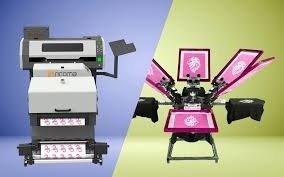In today’s competitive printing industry, businesses and entrepreneurs are constantly evaluating which methods offer the best balance between cost, efficiency, and quality. Among the many options available, Direct-to-Film (DTF) printing and traditional screen printing stand out as two popular choices. While screen printing has been a trusted method for decades, modern DTF solutions are transforming how small enterprises and large companies alike approach customization and production. For those curious about the advantages and differences between these technologies, you can click here to explore an in-depth comparison of their technical aspects.
This article provides a comprehensive analysis of both methods, highlighting their processes, strengths, limitations, and suitability for different business models.
Understanding Traditional Screen Printing:
Screen printing is one of the oldest methods of textile decoration, widely used for apparel, posters, and promotional items. The process involves creating a stencil (or screen) for each color and pressing ink through the mesh onto the fabric.
Key characteristics include:
- Durability: Screen-printed designs, especially on garments, are known for their long-lasting finish.
- Vibrant colors: The layering of thick ink produces bold, striking visuals.
- Best for bulk orders: Because of setup time, screen printing becomes cost-effective when producing large batches.
However, the method comes with limitations. Creating separate screens for multiple colors is time-consuming, and fine details or photographic images are difficult to replicate. Additionally, waste generated during setup and ink cleanup makes it less sustainable compared to newer digital methods.
The Rise of DTF Technology:
Direct-to-Film printing is a relatively new technique but has quickly gained popularity due to its flexibility and affordability. The process involves printing designs onto a special PET film using DTF inks, applying hot-melt powder, and then transferring the design onto various materials with heat.
Distinct advantages include:
- Versatility: Works on cotton, polyester, blends, leather, and even wood or metal surfaces.
- Cost-effective for small runs: Unlike screen printing, there is no need for setup screens, making it efficient for one-off or custom orders.
- High detail reproduction: DTF allows gradients, small text, and photo-like designs with ease.
- Durability and comfort: Transfers are soft to the touch, flexible, and long-lasting after washes.
These features make DTF an attractive choice for small enterprises, startups, and custom design shops aiming to maximize profit with minimal investment.
Cost Comparison:
From a financial standpoint, screen printing is more suited to businesses that regularly produce bulk quantities. The higher upfront labor and material costs (screens, inks, setup time) are spread across large runs, lowering per-unit costs.
DTF, on the other hand, excels in low-to-medium production. With minimal setup required, a single customized T-shirt can be produced profitably. For modern businesses tapping into personalized fashion, online marketplaces, or niche markets, DTF often provides a higher return on investment.
Speed and Efficiency:
Screen printing demands extensive preparation, especially when multiple colors are involved. Designs requiring fine details may need additional processes, slowing production further.
By contrast, DTF printing offers faster turnaround times. Once the design is prepared digitally, it can be printed and transferred directly without complex setups. For small businesses that thrive on quick delivery and customer responsiveness, this speed advantage is crucial.
Environmental Considerations:
Sustainability has become a defining factor in today’s printing industry. Screen printing traditionally involves more water, chemicals, and ink waste, which may not align with eco-conscious business models.
DTF technology, while not entirely waste-free, uses water-based inks and generates significantly less waste during production. This makes it a more environmentally responsible choice, particularly for startups building eco-friendly brands.
Midway Analysis: Why Many Businesses Turn to dtflinko.com:
When businesses weigh their options, guidance and reliable equipment play a critical role in decision-making. Companies such as dtflinko.com are helping bridge the gap by offering advanced DTF solutions that outperform traditional methods in flexibility and cost-effectiveness. Their range of machines is tailored not only for industrial-scale production but also for small enterprises seeking affordable entry into the market.
By providing cutting-edge technology, training, and support, platforms like this empower businesses to experiment with new models without the risks associated with older printing technologies.
Which Method is Best for Your Business?
The choice between DTF and screen printing largely depends on the business’s goals and target market.
- Choose Screen Printing if:
- You regularly handle bulk orders.
- Your designs involve simple colors and limited detail.
- You have the resources to manage longer setup times and higher upfront costs.
- Choose DTF Printing if:
- You serve customers who demand personalization.
- Your orders vary in size and complexity.
- You want flexibility to print on diverse materials.
- Speed and efficiency are critical to your operations.
For many small enterprises, the ability to deliver customized, high-quality products quickly gives DTF printing the clear edge.
Looking Ahead: The Future of Printing Technology
While screen printing will continue to hold value in specific markets, the momentum behind DTF printing is undeniable. As technology advances, we can expect improvements in ink quality, automation, and eco-friendly practices, making it even more appealing for businesses of all sizes.
Entrepreneurs who adopt DTF early are not only investing in advanced printing but also in a business model built on flexibility, creativity, and customer satisfaction.
Conclusion:
Both DTF technology and screen printing have their place in the industry, each with strengths suited to different scenarios. Screen printing thrives in bulk production with bold colors and durability, while DTF shines in customization, versatility, and speed.
For businesses, the decision comes down to aligning printing methods with customer expectations and operational goals. In a world where personalization and fast delivery are in demand, DTF printing offers a forward-looking solution, giving small enterprises and established brands alike the opportunity to innovate and grow.
 Online Clock
Online Clock